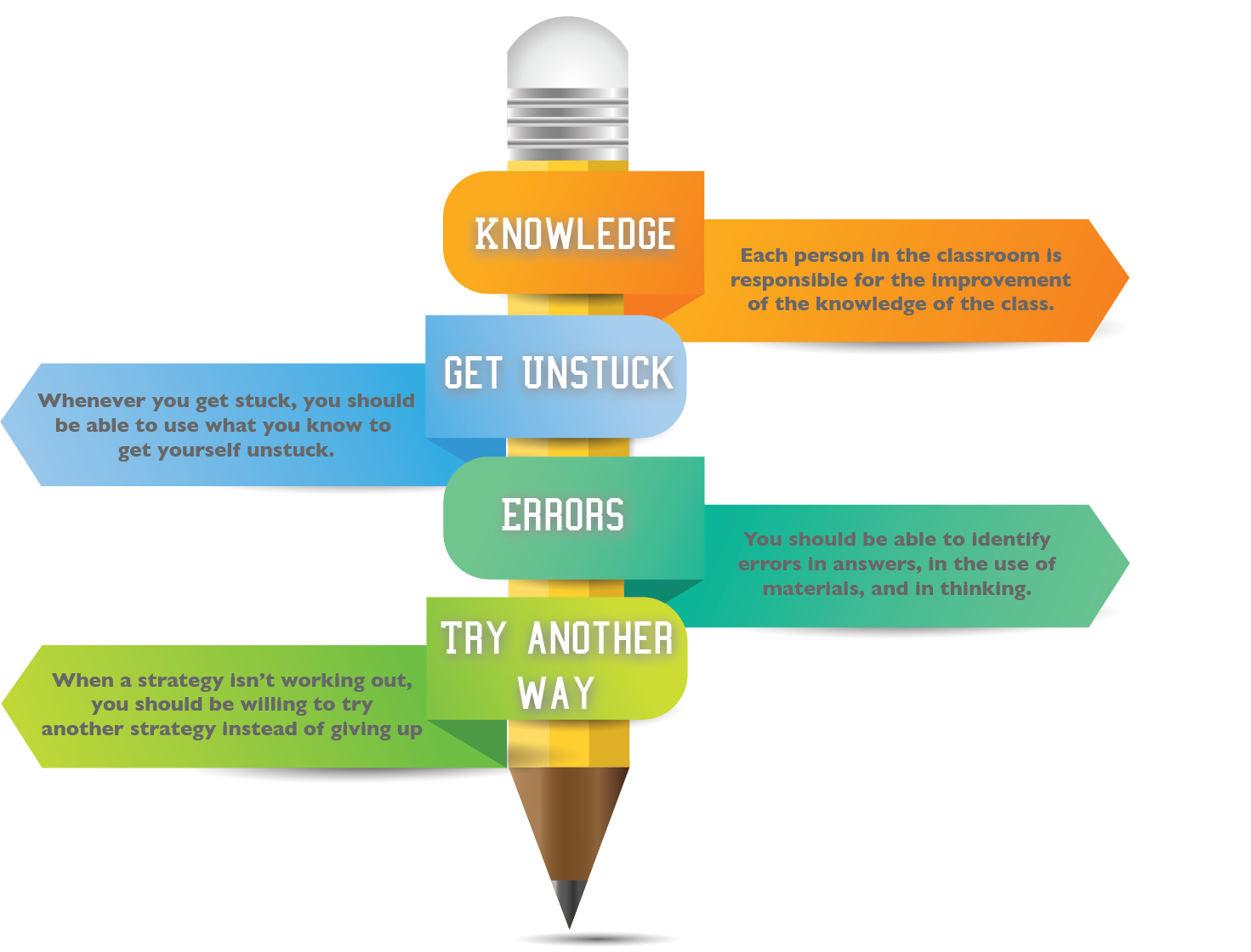
Numerate Environment
Learning is more than Just Getting the Right Answer
What does this mean?
Have you ever judged the success of your lesson by the number of students who got the questions you asked correct… but then realized when you shifted the context for a problem or asked a question in a different way that your students didn’t get it? “Many students think that their role in math class is not to learn but to get questions right – to perform. It is important for them to know that math is about learning, and to know that math is a growth subject, it takes time to learn and it is all about effort.”
(Boaler, 2016)

The assumption that correct answers mean mastery and wrong answers mean learning deficiencies needs to be reimagined. The following learning criteria based, on the work of Greenwood (1993), and Middleton, Hatfield & Tallman (2015) challenges students to think beyond just getting the right answer. The norms found below are designed to be introduced during the first math class of the year. They can be posted (and added to) so they can be referred to daily.

How do I Support This?
The examples below are taken from the following source: Making Connections in Math (see bibliography section)
CONSIDER
Each person in the classroom is responsible for the improvement of the knowledge of the class.
Message to your students: “You should be able eto explain your strategies and thoughts so they are clearly understood by others, not just repeat the steps of what to do to get an answer.
- Provide opportunities for students who recognize their difficulties to make their struggle public so others can learn.
- When students have a particular insight, provide opportunities to share the insight publicly to improve the knowledge of peers.
- Asking open-ended and extended-answer questions. After asking the question there should be time given to the students to think of their response. Even after they respond, try to give more wait-time and also ask the students to explain their response. Students should expect probing questions throughout the year so that they begin to see that more will be expected of them that just the correct answer (Greenwood, 1993; NDT).
- Asking students “why-questions” or “what if questions” to encourage students to think more deeply about their responses (NDT; Reinhart, 2008).
Whenever you get stuck, you should be able to use what you know to get yourself unstuck.
- Answering students questions with questions that will provide clues to help them get unstuck without giving them the answer (Greenwood, 1993).
- Getting student to serve as “strategy teachers.” Students share with the class the difficulties they encountered and the strategies they used to get unstuck (Greenwood, 1993).
- “Always require student to ask a question when they need help. When a student says, “I don’t get it,” he or she may really be saying, “Show me an easy way to do this so I don’t have to think.” By having to ask a question, students are required to think about the problem in enough depth to formulate a question (Reinhart, 2008, p. 93)
You should be able to identify errors in answers, in the use of materials, and in thinking.
- Asking students whether they agree or disagree with something and whether they can spot some mistake. “If something is wrong and you can spot it, that will tell us both that you know it is supposed to be. If nothing is wrong and you think there is, that will tell us something too.” (Greenwood, 1993, p. 146; NDT)
- Requiring multiple responses to the same question. “Always ask for other comments, additions, clarifications, solutions or methods. This request is difficult for students at first because they have been conditioned to believe that only one answer is correct and that only one correct way is possible to solve a problem…To accomplish this…try not to comment after each response…simply pause and wait for the next student to offer comments. If the pause alone does not generate further discussion, …ask, “Next?” Or “What do you think about ______’s idea?” (Reinhart, 2008, p. 93)
Teacher Professional Learning Resources:
Resources to use with your Class and Students:
Children’s Literature Available in IMC
Great Estimations by Bruce Goldstone
Perimeter, Area and Volume (A Monster Book of Dimensions) by David Adler
Online Books
Bibliography and Further Reading
Boaler, J. (2016). Mathematical mindsets: unleashing students potential through creative math, inspiring messages, and innovative teaching. San Francisco, CA: Jossey-Bass & Pfeiffer Imprints.
Greenwood, J. J.. (1993). On the nature of teaching and assessing “mathematical power” and “mathematical thinking”. National Council of Teachers of Mathematics, 41(3), 144–152. Retrieved from https://thinking101canada.files.wordpress.com/2018/04/jj-greenwood.pdf
Middleton, J., Tallman, M., & Hatfield, N. (2015). Taking the severe out of perseverance: Strategies for building mathematical determination. Research Gate, April, 1-22. Retrieved from https://www.researchgate.net/publication/274958715_Taking_the_severe_out_of_perseverance_Strategies_for_building_mathematical_determination
NDT Resource Center. (n.d.). There is Not Always Just One Right Answer. Retrieved October 27, 2019, from https://www.nde-ed.org/TeachingResources/ClassroomTips/Not_Always_One_Right_Answer.htm
Reinhart, S. C. (2008). Never say anything a kid can say! In Growing Professionally Reading from NCT< Publications for grades K-8 (pp. 89–94). Reston, VA: National Council of Teachers of Mathematics.




